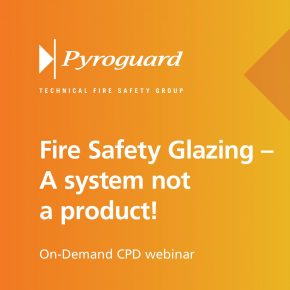
Create a safer construction environment with Bull’s five-step checklist
Bradley Markham, director at Bull Products, a manufacturer of life-saving fire protection equipment, has shared a five-step checklist for construction site managers and health and safety professionals to consider.
This comes as the Health and Safety Executive say construction remains one of the most hazardous industries, accounting for a quarter of all fatal injuries to workers in the UK.
Construction employs 2.2 million people and relies heavily on its dedicated work force – therefore, it is vital that the industry takes all the necessary steps possible to ensure a safer working environment.
Here are the five steps…
Step one – carry out a thorough risk assessment
First and foremost, it is imperative at the start of any project to identify all the risks involved ahead of the work that is being carried out. Conducting a full risk assessment will ensure all employees involved are aware of any hazards that may pose a risk to workers.
Here are some things to consider during the assessment:
- The layout and size of the workplace.
- The type of work that will be carried out and how long the job will take.
- The number of people and plant on the work site.
- The conditions of work, i.e. are there sloping surfaces, will it rain or flood? Are there any electrical hazards or potential falling materials?
- Are walkways and fire exit routes clear of rubbish and equipment?
- How easy is it to access equipment from where the work will take place?
- Are the risks clearly marked to ensure injury is avoided?
Step two – ensure the right products are located on site
Following the risk assessment, it will become much clearer on exactly which products your site requires to ensure maximum site safety and best practice.
From fire extinguishers to alarm systems, through to first aid equipment and spill kits, having the right equipment could mean the difference between life and death.
Fire extinguishers are one of the most important products to have on site. If you’re unsure of which fire extinguisher to have on site, you’re not alone.
A recent survey carried out by our team revealed that more than 38% of workers are using the wrong type of fire extinguisher on an electrical fire, while more than 10% would use a foam extinguisher to put out an electrical fire. However, Bull’s mission is to help you ensure your site is compliant.
Remember the extinguishers should be appropriate to the nature of the potential fire:
- Wood, paper and cloth – water extinguisher
- Flammable liquids – dry powder and foam extinguisher
- Electrical – carbon dioxide (C02) extinguisher
The list of safety products your site may require are endless but each one will prove vital when it matters the most.
Step three – train your staff to maximise safety
Workers should play a large part in managing health and safety risks. Therefore, training your staff is fundamental so that accidents and injuries are avoided.
As a guide, each employee should be familiar with the following:
- The site evacuation procedure including the nearest exists made clear by signage.
- Risks associated with the employee’s working environment and main duties.
- Location of the fire protection and first aid equipment.
- How to use the specific equipment and how to ensure proper use.
- A point of contact should an emergency occur.
- How to report hazards and what risks to look out for.
Step four – provide adequate first aid
Access to first aid can help an injured person make a quicker recovery and even save lives. If your employees become ill or fall injured at work, there is a legal requirement for you to provide appropriate equipment, facilities and personnel to administer the first aid.
The minimum provision for all sites is:
- A first aid box with enough equipment corresponding to the number of workers on site.
- An appointed person to take charge of the first-aid arrangements.
- Clear information telling workers who the appointed first-aid person is and where to find them.
First-aid arrangements should cover shifts, night and weekend working so managers may need to appoint or train several people to ensure adequate cover.
Step five – follow the Work at Height Regulations
Falls are the most common cause of death in the construction industry and account for 50% of fatalities. Before any work is completed at a height, it is crucial to take precautions to prevent or reduce the risk of injury.
The Health and Safety Executive recommends site managers ask themselves the following:
- Have you thought about whether you can avoid working at height by using different equipment or a different work method?
- Can you use equipment that will prevent a fall from happening such as scaffolding or a mobile elevating work platform?
- Can you put in place measures to reduce the distance and consequences of a fall should one happen, for example, nets, soft landing systems or safety decks?
- Will the weather conditions threaten the health and safety of those carrying out the work?
- Have you thought about all the options and are you certain that you’re gaining access to height using the safest means possible?
Latest news

26th March 2025
Encasement Verta column casings - covering up with style
The demands of architects and specifiers seeking to create stylish finishes on a diverse range of building interior and exterior projects are the main drivers behind the versatility and extensive choice available within the Encasement Verta column casing range.
Posted in Articles, Building Industry News, Building Products & Structures, Canopies, Entrances & Column Casings, Case Studies, Interior Design & Construction, Interiors, Restoration & Refurbishment, Retrofit & Renovation, Walls
26th March 2025
Pyroguard launches on-demand CPD webinar
Pyroguard has launched an on-demand version of its RIBA-approved CPD seminar – ‘Fire safety glazing: a system, not a product’ – in a bid to guide the industry regarding the critical role of fire safety glass.
Posted in Articles, Building Industry Events, Building Industry News, Building Products & Structures, Building Services, Continuing Professional Development (CPD's), Glass, Glazing, Health & Safety, Information Technology, Innovations & New Products, Posts, Retrofit & Renovation, Seminars, Training, Windows
25th March 2025
Reduce sound transference with West Fraser CaberAcoustic
CaberAcoustic from West Fraser is a highly versatile, effective and economical sound-reducing flooring solution. Reducing both impact and airborne transmitted sounds, it can be laid over concrete and timber floors in both new and existing buildings.
Posted in Acoustics, Noise & Vibration Control, Articles, Building Industry News, Building Products & Structures, Building Services, Building Systems, Facility Management & Building Services, Floors, Interior Design & Construction, Interiors, Posts, Restoration & Refurbishment, Retrofit & Renovation, Timber Buildings and Timber Products
25th March 2025
Vent-Axia Kicks Off Charity Football Tournament in Support of Cancer Research UK
Ventilation leader Vent-Axia brought together leading building design professionals for an action-packed Charity Powerleague 5-a-side Football Tournament on Thursday 20th March in Shoreditch, London, in aid of Cancer Research UK.
Posted in Air Conditioning, Articles, Building Industry Events, Building Industry News, Building Products & Structures, Building Services, Charity work, Facility Management & Building Services, Heating, Ventilation and Air Conditioning - HVAC
 Sign up:
Sign up: 